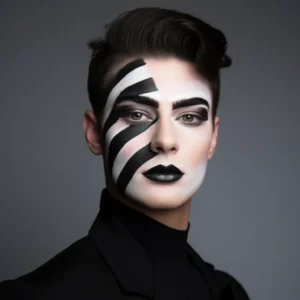The art of makeup has a rich and diverse history that spans across civilizations, cultures, and epochs. While contemporary discussions often center around women’s beauty routines, the use of makeup by men has been a prevalent and culturally significant practice throughout history. This comprehensive exploration delves into the historical evolution of men’s makeup, tracing its roots from ancient civilizations to the present day, and highlighting the various cultural, social, and artistic dimensions that have shaped this enduring aspect of self-expression.
Ancient Beginnings: Mesopotamia, Egypt, and Beyond
Mesopotamian Elegance:
As far back as 4000 BCE, the Mesopotamians laid the groundwork for the use of makeup, and both men and women adorned their faces with a variety of substances. Kohl, a dark powder made from lead sulfide, was a popular choice for outlining the eyes. Men in Mesopotamia used makeup not only for aesthetic purposes but also as a symbol of social status and prestige.
Egyptian Elegance and Symbolism:
In ancient Egypt, makeup transcended mere adornment; it was intertwined with spirituality and symbolism. Men, particularly pharaohs and high-ranking officials, utilized a distinctive black eyeliner made from a mix of minerals like galena and malachite. This eye makeup, known as “mesdemet,” was believed to have protective qualities, warding off evil spirits and promoting good health.
Greek and Roman Influences:
The Greeks and Romans embraced the use of cosmetics, viewing it as a mark of refinement and sophistication. Both men and women used powders, pigments, and perfumes to enhance their features. The pursuit of an idealized form of beauty in these societies drove the widespread use of makeup, with men seeking to emulate the statuesque perfection of their gods.
Medieval Elegance: The Renaissance and Beyond
The Renaissance Revival:
The Renaissance period witnessed a resurgence of interest in classical art and culture, and men’s makeup made a comeback. Pale skin was in vogue, and both men and women used lead-based cosmetics to achieve a fair complexion. The desire for an ethereal aesthetic shaped the makeup practices of the time, influencing the development of new products and techniques.
Aristocratic Extravagance:
Throughout the medieval and Renaissance periods, European nobility adorned themselves with elaborate makeup. Powdered wigs, pale faces, and beauty patches were popular among men of wealth and influence. Makeup became a visible symbol of aristocratic status, emphasizing the stark social divide between the upper and lower classes.
The Duality of the 19th Century: Victorian Restraint and Theatrical Expression
Victorian Restraint:
The 19th century brought about a shift in societal attitudes towards makeup, particularly in Western cultures. The Victorian era, known for its conservative values, saw a decline in the acceptance of men’s makeup in everyday life. However, behind closed doors, some men continued to engage in discreet cosmetic practices to maintain a polished appearance.
Theatrical Flourishes:
While makeup may have retreated from the public eye, it thrived in the theatrical realm. Actors, both male and female, donned elaborate makeup to enhance their stage presence and convey character traits. The exaggerated and expressive nature of theatrical makeup provided a space for men to explore and experiment with their appearance.
The 20th Century: From Hollywood Glamour to Subcultures
Hollywood Glamour:
The advent of cinema in the early 20th century brought with it a new era of glamour and sophistication. Hollywood stars, including leading men, embraced makeup both on and off-screen. The cinematic influence on beauty standards elevated the use of makeup, making it more acceptable for men in the public eye to enhance their features.
Counterculture Movements:
As the 20th century progressed, counterculture movements like the Beat Generation and the hippie movement challenged mainstream norms. Men in these subcultures often rejected traditional notions of appearance, experimenting with makeup to express their anti-establishment sentiments. This period marked a shift towards more androgynous and liberated forms of self-expression.
Contemporary Renaissance: Men’s Makeup in the 21st Century
The Rise of Male Grooming:
The 21st century has witnessed a resurgence of interest in men’s grooming, with an emphasis on skincare and makeup becoming integral to personal care routines. Male beauty influencers and celebrities openly share their grooming and makeup practices, challenging stereotypes and fostering a more inclusive approach to beauty.
Breaking Gender Norms:
In recent years, the beauty industry has taken significant strides towards inclusivity. Makeup brands are increasingly recognizing the diverse needs of their consumers, and marketing campaigns now feature male models and influencers. This shift challenges traditional gender norms, contributing to a more expansive and accepting definition of beauty.
The Future of Men’s Makeup: Navigating New Frontiers
Redefining Masculinity:
The future of men’s makeup holds promise in redefining masculinity. As societal norms continue to evolve, the use of makeup by men may become an integral part of mainstream beauty routines, transcending gender boundaries and contributing to a more inclusive and fluid understanding of masculinity.
Technological Advancements:
Advancements in technology are influencing the landscape of men’s makeup, with virtual try-on experiences and augmented reality tools allowing individuals to experiment with different looks before making a purchase. This technological integration is making makeup more accessible and user-friendly for everyone.
Conclusion:
The journey of men’s makeup throughout history is a testament to its resilience and cultural significance. From ancient civilizations to the present day, men have engaged in the art of cosmetics for reasons ranging from spirituality and symbolism to social status and self-expression. As we navigate the complexities of contemporary beauty standards, the history of men’s makeup serves as a reminder that the desire for self-expression and enhancement transcends time, and the evolving narrative is one of inclusivity, acceptance, and the celebration of diversity. The canvas of men’s faces continues to be painted with the strokes of history, culture, and individuality, creating a vibrant tapestry of beauty that knows no gender bounds.


